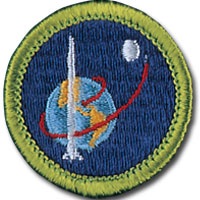Virgin Galactic






Space Exploration Merit Badge Supplementals
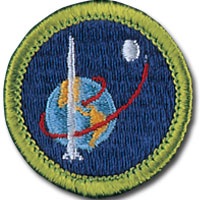
(created Fri. Mar. 31, 2017; updated Mon. Apr. 15, 2019)
This is an extension of
the Space Exploration Merit Badge page.

This page is a supplement to the Boy Scout Space Exploration Merit Badge. None of the information is needed to complete the merit badge. The page exists solely to provide additional insights about all that is exciting about the exploring the universe beyond our planet, in person and through unmanned spacecraft.

The purpose of this page is to provide more information about Virgin Galactic.

Company website: https://www.virgingalactic.com
Virgin Galactic is the aerospace company started by Sir Richard Branson, who had a chance to invest in funding/sponsoring the original Ansari X-Prize (more on the X-Prize, below), and turned it down.
Background on the X-Prize and how it led to Virgin Galactic...
(more insights are provided at the bottom of this page)
Peter Diamandis started the X-Prize inspire for space travel what that Orteig Prize did for aviation... the $25,000 Orteig Prize inspired Charles Lindbergh to become the first pilot to cross the Atlantic solo, non-stop... in his Spirit of St. Louis monoplane. This ushered in the age of aviation and passenger air travel.
The X-Prize inspired teams for passenger space travel... the winner needed to launch a reusable spacecraft into space twice in two weeks... launch passengers higher than the Karman Line, which is the 62-mile / 100-kilometer altitude that is the generally viewed altitude where space begins.
The X-Prize was won by the team that was led by Burt Rutan, who has invented many airplanes and who along with Jeana Yeager co-piloted the around-the-world flight (without refueling) of the Voyager in 1984, and which was financially backed by Microsoft co-founder Paul Allen.
SpaceShip One was piloted by Mike Melvill and Brian Binnie to win the Ansari X-Prize in 2004.
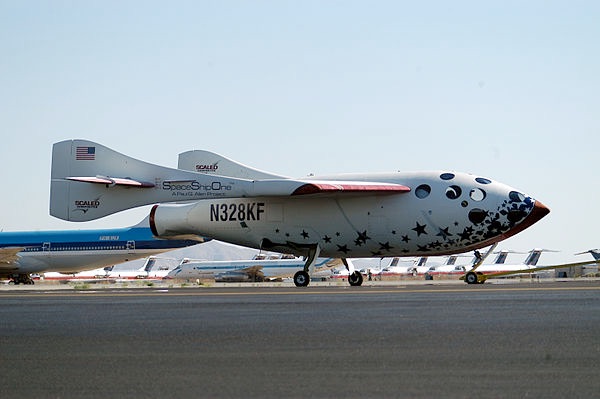
image source: https://en.wikipedia.org/wiki/SpaceShipOne
After that success, Branson realized he could still get involved with space tourism and he started Virgin Galactic to commercialize space travel. He joked in the book “How to Make a Spaceship,” that he turned down the chance to fund / sponsor the X-Prize and instead made a significant larger investment in Virgin Galactic.
Virgin Galactic quickly set out to make a larger SpaceShipTwo, to carry more passengers. While setback by a crash in 2014, and the death of co-pilot Michael Alsbury, they are continuing to pursue their goal of public spaceflight with their current VSS UNITY spaceship.

“Since the dawn of the space age, only 558 humans have traveled above the Earth’s atmosphere and into space. Throughout five decades of human spaceflight, the national space agencies in the United States, Russia, and China have inspired the world. But because government space agencies are not asked to help ordinary citizens to become astronauts, most of our planet’s seven billion people have had no opportunity to experience space and all of its possibilities for themselves, regardless of their passion or talents.
“Virgin Galactic is changing that. Our purpose is to become the spaceline for Earth; democratizing access to space for the benefit of life on Earth.”
source: http://www.virgingalactic.com/human-spaceflight/

While NASA and many US companies, and while other countries and their space programs are focused on many aspects of space exploration, several companies are working to develop space tourism - the ability for you and me to go into space.
Virgin Galactic is one. When they reference “suborbital” they are sharing that they don’t plan to send passengers around the earth. Instead of putting us in orbit they plan to send us up and bring us back down, likely all over the US, likely from SpacePort America, in New Mexico.
Virgin Galactic’s goal is similar to Blue Origin; they are just taking different approaches in how they design their passenger spacecraft.
What are some of the current companies working to launch space missions?
Helpful resources to determine the answer include:
https://en.wikipedia.org/wiki/List_of_private_spaceflight_companies

On January 11, 2018, Virgin Galactic completed another step in their VSS Unity program:
“ICYMI VSS Unity completed her 7th glide flight test this morning. For more information on today's flight head to our website http://virg.in/J5G #SpaceShipTwo Getting #NMReady”

On December 3, 2016, Virgin Galactic’s new spaceships the VSS Unity, completed its first free flight. For this first gliding test flight, VSS Unity was flying light and slow, and over the 10-minute flight, achieving a maximum speed of approximately Mach 0.6 while gliding home from an altitude of 50,000 feet.
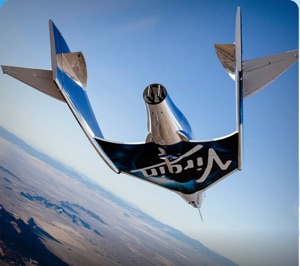
source: http://www.virgingalactic.com/welcome-virgin-orbit/

SpaceShipOne wins the X-Prize
“In 1919 Raymond Orteig offered a prize of $25,000 for the first nonstop aircraft flight between New York and Paris.”
The Orteig Prize inspired Charles Lindbergh to be the first pilot to cross the Atlantic Ocean.
“At 7.52 AM, May 20th, 1927 a small single-engine aircraft took off from Roosevelt Field, Long Island. 33 hours later, on May 21st, the same aircraft landed at Le Bourget Airport, Paris.”
source: http://charleslindbergh.com/plane/orteig.asp
In the 1960s to 1990s, Peter Diamandis wanted spaceflight to exist for everyone. Inspired by The Orteig Prize, Peter took a similar approach and created the Ansari X-Prize.
“Funded by the Ansari family, the Ansari XPRIZE challenged teams from around the world to build a reliable, reusable, privately financed, manned spaceship capable of carrying three people to 100 kilometers above the Earth's surface twice within two weeks. The prize was awarded in 2004 and along with it, a brand new private space industry was launched.”
source: https://ansari.xprize.org
Space Ship One was designed by legend Burt Rutan, of Scaled Composites, and financed by Paul Allen, founder of Microsoft and one-time majority shareholder of Charter Communications.
For the first flight, the pilot of SpaceShipOne was Mike Melvill. ”Through SpaceShipOne flight 15P in 2004, he is known as the first privately funded human spaceflight mission pilot to reach space.”
Source: https://en.wikipedia.org/wiki/Mike_Melvill
For the second flight, the pilot of SpaceShipOne was Brian Binnie, who rocketed to an altitude of 347,442 feet, or 69.6 miles above Earth’s surface.
“On December 17, 2003, the 100th anniversary of the Wright brothers' first powered flight, Binnie piloted the first powered test flight of SpaceShipOne, flight 11P, which reached a top speed of Mach 1.2 and a height of 12.9 miles (20.7 km). On October 4, 2004, he piloted SpaceShipOne's second Ansari X Prize flight, flight 17P, winning the X Prize and becoming the 435th person to go into space. His flight, which peaked at 367,442 feet (69.6 mi; 112.0 km), set a winged aircraft altitude record,[4] breaking the old record set by the North American X-15 in 1963.[5] It also earned him the second set of Astronaut Wings to be given by the FAA for a flight aboard a privately operated commercial spacecraft.[6]”
source: https://en.wikipedia.org/wiki/Brian_Binnie

The X-Prize was presented to Mr. Rutan on the football field of St. Louis University High School (SLUH), next door to the St. Louis Science Center on a beautiful, cloudless October day in 2004.
Our son now attends SLUH and no, we had no expectation then that he would a student at SLUH now.
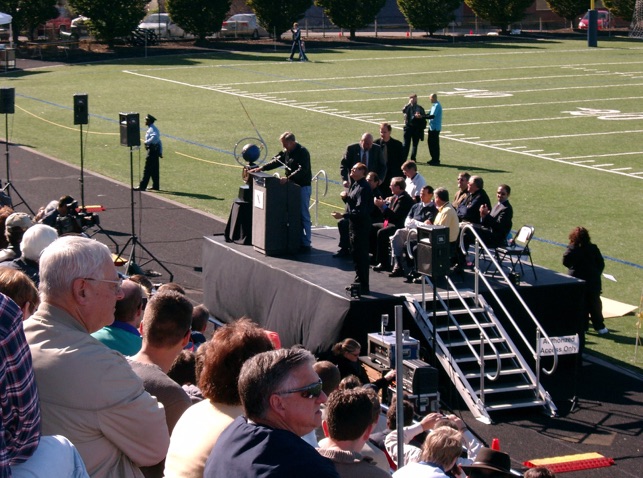
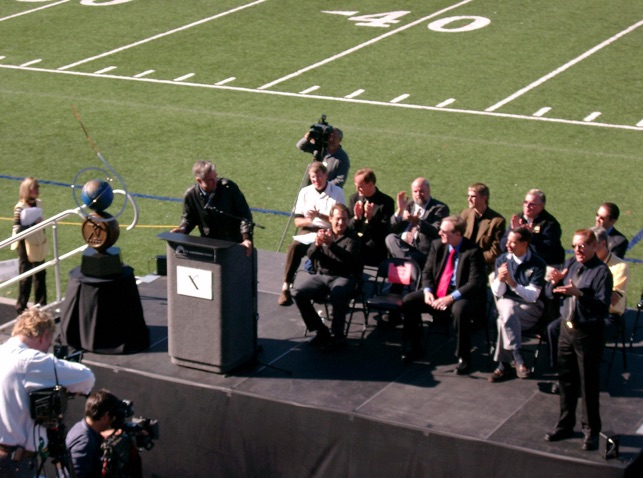
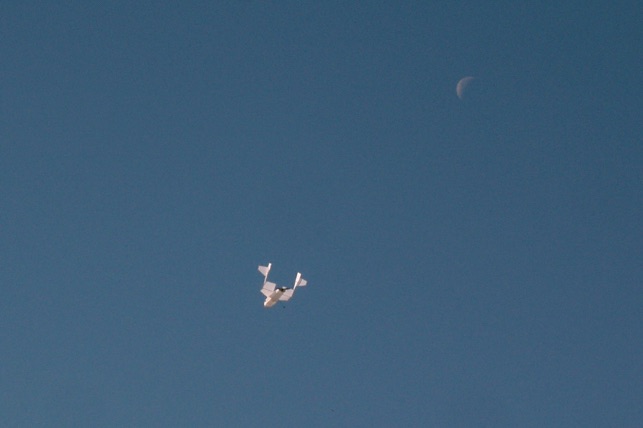
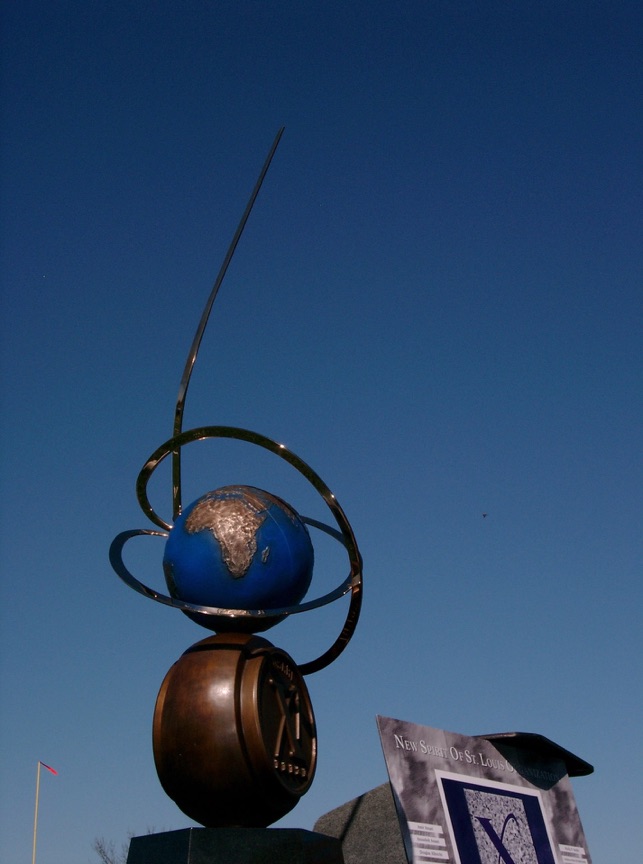

Scaled Composite’s Space Ship One was designed to 1) carry three humans (one of them a pilot) in a sea-level pressurized cabin, 2) be propelled by rocket from an altitude of 15 km (9.3 mi) to in excess of 100 km (62 mi), 3) reenter atmosphere and shed kinetic energy in an aerodynamically stable configuration, 4) glide transonically and subsonically, and 5) land horizontally on a standard runway
The Space Ship One space plane was carried from the runway to altitude by the launch craft the White Knight. After about an hour of ascent, to 8.7 miles altitude, the Space Ship One was then drop-released and briefly glides unpowered. After rocket ignition, it climbs at a 65-degree angle, passing Mach 3.5 and inducing stresses of 4g. The burn takes the craft to 62 miles / 100 kilometers altitude. The stabilizer wings then flip, allowing some moments of weightlessness before descending like a normal plan to the runway, over the course of 20 minutes or so. Sir Richard Branson has since partnered with Mr. Rutan to create Virgin Galactic, to provide such flights for the public.
Virgin Galactic was formed in 2004 by Sir Richard Branson and Burt Rutan, to provide sub-orbital tourist flights into space. These are flights into space that do not orbit the entire earth. Virgin Galactic does also plan eventual orbital flights as well.

“As the world’s first spaceline, we are by our very nature futuristic. Although we’re focused on getting SpaceShipTwo and LauncherOne into commercial service, those two projects are also a start towards even greater things.
“We believe that in the future, life on Earth will be made better by the exploration of space. Children inspired by meeting and relating to astronauts from their communities will grow up to start new businesses and found new companies. Students who fly suborbital experiments while still in school will have an enormous head start on their careers, gaining experience that the current generation of leaders didn’t have until they had been in the workforce for decades. Companies and organizations that launch small satellites will deliver important data and help saves lives and identify new resources.
“Here at Virgin Galactic, we’ll still be hard at work to further open the space frontier. Someday, we’ll have learned so much from flying SpaceShipTwo and LauncherOne that we can retire those vehicles and debut SpaceShipThree and LauncherTwo, and so on and so forth. While it’s far too soon to say what those vehicles will look like or even what they will do, our founder is particularly fond of the idea of hypersonic point-to-point transportation, using a mix of SpaceShipTwo and LauncherOne fundamental technologies.
“What seems almost certain, though, is that the things that most inspire us fifty years from now will be ideas no one has even considered yet today. We know first hand that space exploration has a uniquely powerful ability to spark the imagination and to motivate the next generation of leaders. Beyond all of the concrete and near-term benefits of human spaceflight and of small satellite launch, what we are most excited about is perhaps exactly that: the power and freedom of imagination.”
source: http://www.virgingalactic.com/why-we-go/

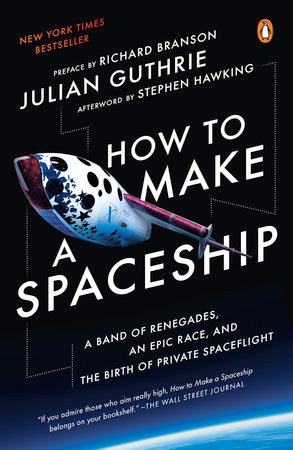
The book “How to Make a Spaceship” was written by Julian Guthrie, to share the history of the X-Prize, how SpaceShip One and several legitimate competitors vied for the X-Prize, and how SpaceShip One won the X-Prize.
It reinforces the value of determination, especially when pursuing your dreams.
I do recommend reading this book.
Links:

Still dreaming of space
“One area Branson has been less keen on speaking out on recently has been his project to take people into space. Virgin Galactic, as the fledgling business is known, has been beset by technical and other difficulties, not least the fatal crash of its SpaceShipTwo in California’s Mojave Desert in October 2014.
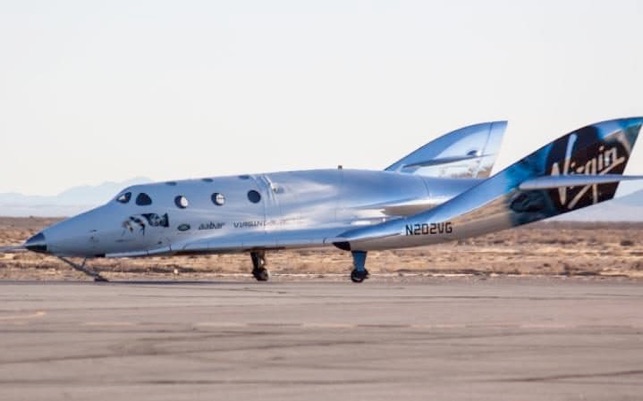
<img src="/content/dam/news/2016/12/04/JS115223769_REUTERS_Virgin-Galactics-SpaceShipTwo-NEWS-small_trans_NvBQzQNjv4BqxnlSljj15z1o8iKqMGA7t3hiS0g7AdK0YoFqPi2pTRU.jpg" alt="Virgin Galactic's SpaceShipTwo, dubbed the VSS Unity, lands after completing its first ever free-flight test over Mojave, California in December 2016" width="319" height="199" class="responsive-image--fallback"/>
Virgin Galactic's SpaceShipTwo, dubbed the VSS Unity, lands after completing its first ever free-flight test over Mojave, California in December 2016
“Despite the idea proving popular with future travellers – some 500 potential customers have spent $250,000 on reserving their spot on one of its trips– it is perhaps the one business he has found the hardest to get off the ground.
“After the crash, Branson said his dream of space travel may have ended. But Galactic, under boss and former NASA chief of staff George Whitesides, has regrouped, redoubled its focus on safety, and appears to be making progress.
“Last August it received its first operating licence from the US Federal Aviation Authority, subject to a series of conditions, including the regulator verifying testing results before any passengers can board its SpaceShipTwo – designed to hold two pilots and six passengers – which will be carried by launch craft White Knight Two 62 miles into the sky.
“The test programme is going really well, and as long as we’ve got our brave test pilots pushing it to the limit we think that after whatever it is, 12 years of hard work, we’re nearly there.”
“When exactly will he be nearly there? After all, Branson himself – and some of his family – have committed to being on the first flight.
“Well we stopped giving dates,” he confesses. “But I think I’d be very disappointed if we’re not into space with a test flight by the end of the year and I’m not into space myself next year and the progamme isn’t well underway by the end of next year.”
“Whether that date holds is open to debate, but it is clear that despite his years – he turns 67 in July – the bearded billionaire is far from slowing down. “
source:



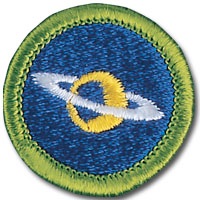
These are all of the links to the Astronomy Merit Badge pages:
Astronomy Merit Badge - Extra “Fun Facts”
Astronomy - Great American Eclipse
Astronomy - Great American Eclipse 2017

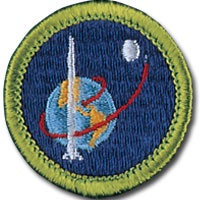
These are all of the links to the Space Exploration Merit Badge pages:
New Horizons - Mission Overview
New Horizons - Pluto Resources


All images were scanned directly from the magazine using the Halo Scanner Mouse - http://shop.halo2cloud.com/collections/computer-and-backup/products/scanner-mouse, which I received as a Christmas present from my mother in 2013.



Regardless your desire to pursue a career in space exploration, it is hoped that you learned enough about exploring space through this merit badge to at least be interested to continuously look up at the sky in awe and wonder, and think about what you may want to explore if you were to go “out there” or were to send a probe “out there.”
If you pursue with enthusiastic interest, that’s great. If you do make a career in the field, GREAT.
May all be better off having completed your Space Exploration Merit Badge than you were before you started.
